What Are Moles?
Moles are small, usually dark, skin growths that can appear anywhere on the body. They are extremely common, with most people having at least a few moles on their skin. But what exactly are moles, and why do we get them?
The Science Behind Moles
Moles occur when skin cells called melanocytes grow in clusters instead of being spread out evenly. This clustering of cells causes the skin to darken, resulting in a mole. Moles can appear at any time, even in childhood, and they can change over time, growing larger or darker.
Most moles are harmless and don’t require treatment. However, it’s essential to keep an eye on them, as some moles can be cancerous. If you notice any changes in a mole, such as an increase in size, color, or shape, it’s crucial to consult a dermatologist.
Types of Moles
While most moles are benign, there are different types, each with distinct characteristics. Let’s explore some of the most common types of moles:
Common Moles
These are the most common type of mole, accounting for about 90% of all moles. They are usually small, round, and dark brown or black. Common moles can appear anywhere on the body and are often found in areas exposed to the sun.
Dysplastic Nevi
Also known as atypical moles, dysplastic nevi are larger and more irregular in shape than common moles. They can be flat or raised and may have multiple colors. While they are benign, people with dysplastic nevi are at a higher risk of developing melanoma.
Seborrheic Keratoses
These moles are usually dark brown or black and have a rough, wart-like texture. Seborrheic keratoses are benign and often appear in older adults. They can be itchy or tender, but they are not cancerous.
Blue Nevi
Blue nevi are rare and usually appear as small, blue or blue-gray moles. They can be found on the skin or in the eye. While they are benign, blue nevi can be mistaken for melanoma, so it’s essential to consult a dermatologist if you notice any changes.
Remember, it’s always better to be safe than sorry when it comes to moles. If you’re concerned about a mole or have questions about skin health, consult a dermatologist or visit Yesil Health AI for evidence-based health answers. 🌟
Stay tuned for more information on moles, including how to identify potential skin cancer and the best ways to prevent moles from forming in the first place! 🌞

Moles vs. Skin Cancer: What’s the Difference?
When it comes to moles, many of us are left wondering: are they harmless or a sign of something more sinister? With skin cancer being a growing concern, it’s essential to understand the difference between moles and skin cancer.
What are Moles?
Moles are growths on the skin that are usually brown or black and can appear anywhere on the body. They are caused by a cluster of pigmented cells called melanocytes, which produce the pigment melanin. Moles are extremely common, and most people have at least a few on their body. In fact, it’s estimated that the average person has between 10 to 40 moles!
What is Skin Cancer?
Skin cancer, on the other hand, is a type of cancer that develops in the skin cells. It occurs when there is an uncontrolled growth of abnormal skin cells, which can invade and damage surrounding tissue. Skin cancer can appear in various forms, including melanoma, basal cell carcinoma, and squamous cell carcinoma.
The Difference Between Moles and Skin Cancer
So, how do you know if a mole is just a harmless growth or a sign of skin cancer? Here are some key differences to look out for:
- Shape and Size: Moles are usually round or oval in shape and are less than 6mm in diameter. Skin cancer, on the other hand, can be irregularly shaped and may be larger in size.
- Color: Moles are typically brown or black, while skin cancer can be flesh-colored, pink, or even white.
- Border: Moles have a clear, defined border, whereas skin cancer often has an irregular or notched border.
- Evolution: Moles tend to remain the same size and shape over time, while skin cancer can grow and change rapidly.
It’s essential to keep an eye on your moles and monitor any changes. If you notice any unusual changes, such as bleeding, itching, or rapid growth, consult a dermatologist immediately. Early detection is key in treating skin cancer!
Moles Causes and Risk Factors
Now that we’ve covered the difference between moles and skin cancer, let’s dive into the causes and risk factors of moles.
What Causes Moles?
Moles are caused by a combination of genetic and environmental factors. Exposure to the sun, hormonal changes, and genetic predisposition can all contribute to the development of moles. In some cases, moles can also be triggered by certain medical conditions, such as neurofibromatosis.
Risk Factors for Moles
Certain individuals are more prone to developing moles, including:
- Fair Skin: People with fair skin are more susceptible to moles due to their skin’s reduced ability to protect itself from the sun.
- Family History: If you have a family history of moles or skin cancer, you may be more likely to develop moles.
- UV Exposure: Prolonged exposure to UV radiation from the sun or tanning beds can increase your risk of developing moles.
By understanding the causes and risk factors of moles, you can take steps to reduce your risk and maintain healthy, mole-free skin! 🌞

Moles Symptoms and Characteristics
When it comes to moles, it’s essential to understand their symptoms and characteristics to differentiate them from other skin growths. Moles are benign growths that can appear anywhere on the body, and they can vary in size, shape, and color.
What Do Moles Look Like?
Moles can appear as small, dark spots or bumps on the skin. They can be flat or raised, and their color can range from pink, brown, black, or even blue. Some moles may be hairless, while others may have hair growing from them. Moles can be round, oval, or irregularly shaped, and they can appear alone or in clusters.
Common Characteristics of Moles
Most moles share certain characteristics, including:
- Size: Moles are usually less than 1/4 inch (6 mm) in diameter.
- Shape: Moles can be round, oval, or irregularly shaped.
- Color: Moles can be brown, black, pink, or blue.
- Border: Moles usually have a clear, defined border.
- Surface: Moles can be smooth, rough, or bumpy.
Moles Diagnosis and Identification
Diagnosing moles typically involves a visual examination by a dermatologist or healthcare professional. In some cases, a biopsy may be necessary to rule out skin cancer.
How Are Moles Diagnosed?
A dermatologist will typically examine the mole visually, looking for the ABCDE rule:
- A: Asymmetry: If the mole is not symmetrical.
- B: Border: If the mole has an irregular, notched, or scalloped border.
- C: Color: If the mole has multiple colors or uneven color distribution.
- D: Diameter: If the mole is larger in diameter than a pencil eraser (about 6 mm).
- E: Evolving: If the mole is changing in size, shape, or color.
If the mole exhibits any of these characteristics, a biopsy may be necessary to determine if it’s cancerous.
Remember, it’s essential to monitor your moles and keep an eye out for any changes. If you’re concerned about a mole, don’t hesitate to consult a dermatologist for a professional evaluation 🤕.

Moles Removal Options and Procedures
Are you tired of dealing with unwanted moles on your skin? Whether they’re causing discomfort, affecting your self-confidence, or simply bothering you, there are several moles removal options and procedures available to help you get rid of them. In this section, we’ll explore the different methods, their effectiveness, and what you can expect from each procedure.
Surgical Excision
Surgical excision is a common method for removing moles. This procedure involves numbing the area with a local anesthetic, making a small incision, and then removing the mole. The wound is then closed with stitches or left to heal on its own. This method is usually effective for removing moles, but it may leave a small scar.
Laser Removal
Laser removal is a non-invasive procedure that uses high-energy light beams to break down the mole. This method is often used for smaller moles and can be less effective for larger ones. Laser removal may require multiple sessions, and it’s essential to find a qualified practitioner to ensure the best results.
Cryotherapy
Cryotherapy involves freezing the mole using liquid nitrogen. This method is often used for smaller moles and can be less effective for larger ones. Cryotherapy may require multiple sessions, and it’s essential to find a qualified practitioner to ensure the best results.
Shave Excision
Shave excision is a procedure that involves shaving off the mole using a specialized tool. This method is usually used for moles that are raised above the skin’s surface. Shave excision is a quick and relatively painless procedure, but it may not be as effective for deeper moles.
Moles Prevention and Skin Care Tips
Preventing moles from forming or reducing their appearance can be achieved through a combination of good skin care habits and sun protection. Here are some tips to help you prevent moles and keep your skin healthy:
Wear Sunscreen
UV rays are a significant contributor to mole formation. Wearing a broad-spectrum sunscreen with at least SPF 30 daily can help reduce the risk of mole formation. Look for sunscreens containing zinc oxide or titanium dioxide for optimal protection.
Wear Protective Clothing
Covering up with clothing, hats, and sunglasses can help prevent UV rays from penetrating your skin. This is especially important during peak sun hours (10 am – 4 pm).
Exfoliate Regularly
Exfoliating regularly can help remove dead skin cells and promote healthy skin cell growth. Use a gentle exfoliant containing alpha-hydroxy acids (AHAs) or beta-hydroxy acids (BHAs) 2-3 times a week.
Moisturize
Keeping your skin hydrated is essential for maintaining healthy skin. Use a moisturizer containing hyaluronic acid, ceramides, or niacinamide to lock in moisture and support the skin’s natural barrier function.
Avoid Tanning Beds
Tanning beds emit UV rays, which can increase the risk of mole formation. Avoid using tanning beds and opt for sunless tanning products instead.
By following these tips and being mindful of your skin, you can reduce the risk of mole formation and maintain healthy, glowing skin. Remember to consult a dermatologist if you have any concerns about moles or skin health. 💡

Frequently Asked Questions about Moles
What are moles on skin?
A mole is a small growth on the skin that is usually dark in color. Moles can appear anywhere on the body and can be flat or raised. They are very common and usually harmless.
What causes moles on skin?
Moles are caused by a cluster of pigmented cells called melanocytes. These cells produce the pigment melanin, which gives skin its color. Moles can appear at any time of life, even in childhood.
How to remove moles?
There are several ways to remove moles, including surgical excision, laser removal, and cryotherapy. It’s essential to consult a dermatologist to determine the best removal method for your mole.
Can moles be cancerous?
While most moles are benign, some can be cancerous. It’s crucial to monitor your moles for any changes in size, shape, or color. If you notice any unusual changes, consult a dermatologist.
How to prevent moles?
While it’s not possible to completely prevent moles, you can reduce your risk by protecting your skin from the sun, avoiding tanning beds, and wearing protective clothing.
What is the difference between a mole and a freckle?
A mole is a cluster of pigmented cells, while a freckle is a small, dark spot on the skin caused by a concentration of melanin. Freckles are usually smaller and lighter than moles.
Can I remove moles at home?
It’s not recommended to try to remove moles at home, as this can lead to infection, scarring, and skin damage. Consult a dermatologist for safe and effective mole removal.
How to cover up moles?
There are several ways to cover up moles, including using concealer, foundation, or camouflage makeup. You can also use mole cover-up products specifically designed for this purpose.
What is the best way to get rid of moles on face?
The best way to get rid of moles on the face is to consult a dermatologist or a qualified skincare professional. They can recommend the most effective removal method for your individual case.
Can moles be a sign of skin cancer?
While most moles are benign, some can be a sign of skin cancer. If you notice any unusual changes in your moles, such as asymmetry, border irregularity, color changes, or diameter increase, consult a dermatologist.
How to prevent moles from growing?
While it’s not possible to completely prevent moles from growing, you can reduce your risk by protecting your skin from the sun, avoiding tanning beds, and wearing protective clothing.
What is the cost of mole removal?
The cost of mole removal varies depending on the removal method, location, and dermatologist’s fees. Consult a dermatologist to determine the best removal method and cost for your individual case.
Can moles be removed with laser?
Yes, laser removal is a common method for removing moles. This method uses a high-energy beam of light to break down the mole, which is then absorbed by the body.
How long does it take to remove a mole?
The time it takes to remove a mole depends on the removal method and the size and location of the mole. In general, surgical excision can take around 30 minutes to an hour, while laser removal may take several sessions.
Is mole removal painful?
The level of pain during mole removal varies depending on the removal method and individual tolerance. Topical anesthetics or local anesthesia can be used to minimize discomfort.
What are the risks of mole removal?
The risks of mole removal include infection, scarring, skin discoloration, and temporary discomfort. It’s essential to consult a dermatologist to discuss the potential risks and benefits of mole removal.
Can I remove moles naturally?
While there are some natural remedies that claim to remove moles, there is limited scientific evidence to support their effectiveness. Consult a dermatologist for safe and effective mole removal methods.
How to prevent moles from coming back?
To prevent moles from coming back, it’s essential to protect your skin from the sun, avoid tanning beds, and wear protective clothing. Regular skin checks can also help detect any new moles.
What is the best mole removal cream?
There are several mole removal creams available, but it’s essential to consult a dermatologist to determine the best cream for your individual case. Some creams may not be effective or may have adverse side effects.
Can moles be removed during pregnancy?
It’s generally recommended to avoid mole removal during pregnancy, as the procedure may pose risks to the mother and fetus. Consult a dermatologist and obstetrician to discuss the potential risks and benefits.
How to remove moles on face naturally?
While there are some natural remedies that claim to remove moles, there is limited scientific evidence to support their effectiveness. Consult a dermatologist for safe and effective mole removal methods.
What is the best way to get rid of moles on neck?
The best way to get rid of moles on the neck is to consult a dermatologist or a qualified skincare professional. They can recommend the most effective removal method for your individual case.
Can moles be removed with apple cider vinegar?
There is limited scientific evidence to support the effectiveness of apple cider vinegar in removing moles. Consult a dermatologist for safe and effective mole removal methods.
How to remove moles with castor oil?
There is limited scientific evidence to support the effectiveness of castor oil in removing moles. Consult a dermatologist for safe and effective mole removal methods.
What is the best way to get rid of moles on back?
The best way to get rid of moles on the back is to consult a dermatologist or a qualified skincare professional. They can recommend the most effective removal method for your individual case.
Can moles be removed with tea tree oil?
There is limited scientific evidence to support the effectiveness of tea tree oil in removing moles. Consult a dermatologist for safe and effective mole removal methods.
How to remove moles with iodine?
There is limited scientific evidence to support the effectiveness of iodine in removing moles. Consult a dermatologist for safe and effective mole removal methods.
What is the best way to get rid of moles on arms?
The best way to get rid of moles on the arms is to consult a dermatologist or a qualified skincare professional. They can recommend the most effective removal method for your individual case.
Can moles be removed with garlic?
There is limited scientific evidence to support the effectiveness of garlic in removing moles. Consult a dermatologist for safe and effective mole removal methods.
How to remove moles with baking soda?
There is limited scientific evidence to support the effectiveness of baking soda in removing moles. Consult a dermatologist for safe and effective mole removal methods.
What is the best way to get rid of moles on legs?
The best way to get rid of moles on the legs is to consult a dermatologist or a qualified skincare professional. They can recommend the most effective removal method for your individual case.
Can moles be removed with hydrogen peroxide?
There is limited scientific evidence to support the effectiveness of hydrogen peroxide in removing moles. Consult a dermatologist for safe and effective mole removal methods.
How to remove moles with aloe vera?
There is limited scientific evidence to support the effectiveness of aloe vera in removing moles. Consult a dermatologist for safe and effective mole removal methods.
What is the best way to get rid of moles on chest?
The best way to get rid of moles on the chest is to consult a dermatologist or a qualified skincare professional. They can recommend the most effective removal method for your individual case.
Can moles be removed with coconut oil?
There is limited scientific evidence to support the effectiveness of coconut oil in removing moles. Consult a dermatologist for safe and effective mole removal methods.
How to remove moles with turmeric?
There is limited scientific evidence to support the effectiveness of turmeric in removing moles. Consult a dermatologist for safe and effective mole removal methods.
What is the best way to get rid of moles on hands?
The best way to get rid of moles on the hands is to consult a dermatologist or a qualified skincare professional. They can recommend the most effective removal method for your individual case.
Can moles be removed with olive oil?
There is limited scientific evidence to support the effectiveness of olive oil in removing moles. Consult a dermatologist for safe and effective mole removal methods.
How to remove moles with honey?
There is limited scientific evidence to support the effectiveness of honey in removing moles. Consult a dermatologist for safe and effective mole removal methods.
What is the best way to get rid of moles on feet?
The best way to get rid of moles on the feet is to consult a dermatologist or a qualified skincare professional. They can recommend the most effective removal method for your individual case.
Can moles be removed with lemon juice?
There is limited scientific evidence to support the effectiveness of lemon juice in removing moles. Consult a dermatologist for safe and effective mole removal methods.
How to remove moles with ginger?
There is limited scientific evidence to support the effectiveness of ginger in removing moles. Consult a dermatologist for safe and effective mole removal methods.
What is the best way to get rid of moles on scalp?
The best way to get rid of moles on the scalp is to consult a dermatologist or a qualified skincare professional. They can recommend the most effective removal method for your individual case.
Can moles be removed with cinnamon?
There is limited scientific evidence to support the effectiveness of cinnamon in removing moles. Consult a dermatologist for safe and effective mole removal methods.
How to remove moles with rosewater?
There is limited scientific evidence to support the effectiveness of rosewater in removing moles. Consult a dermatologist for safe and effective mole removal methods.
What is the best way to get rid of moles on ears?
The best way to get rid of moles on the ears is to consult a dermatologist or a qualified skincare professional. They can recommend the most effective removal method for your individual case.
Can moles be removed with basil?
There is limited scientific evidence to support the effectiveness of basil in removing moles. Consult a dermatologist for safe and effective mole removal methods.
How to remove moles with peppermint?
There is limited scientific evidence to support the effectiveness of peppermint in removing moles. Consult a dermatologist for safe and effective mole removal methods.
What is the best way to get rid of moles on nose?
The best way to get rid of moles on the nose is to consult a dermatologist or a qualified skincare professional. They can recommend the most effective removal method for your individual case.
Can moles be removed with eucalyptus?
There is limited scientific evidence to support the effectiveness of eucalyptus in removing moles. Consult a dermatologist for safe and effective mole removal methods.
How to remove moles with lavender?
There is limited scientific evidence to support the effectiveness of lavender in removing moles. Consult a dermatologist for safe and effective mole removal methods.
What is the best way to get rid of moles on lips?
The best way to get rid of moles on the lips is to consult a dermatologist or a qualified skincare professional. They can recommend the most effective removal method for your individual case.
Can moles be removed with chamomile?
There is limited scientific evidence to support the effectiveness of chamomile in removing moles. Consult a dermatologist for safe and effective mole removal methods.
How to remove moles with sage?
There is limited scientific evidence to support the effectiveness of sage in removing moles. Consult a dermatologist for safe and effective mole removal methods.
What is the best way to get rid of moles on eyebrows?
The best way to get rid of moles on the eyebrows is to consult a dermatologist or a qualified skincare professional. They can recommend the most effective removal method for your individual case.
Can moles be removed with thyme?
There is limited scientific evidence to support the effectiveness of thyme in removing moles. Consult a dermatologist for safe and effective mole removal methods.
How to remove moles with oregano?
There is limited scientific evidence to support the effectiveness of oregano in removing moles. Consult a dermatologist for safe and effective mole removal methods.
What is the best way to get rid of moles on forehead?
The best way to get rid of moles on the forehead is to consult a dermatologist or a qualified skincare professional. They can recommend the most effective removal method for your individual case.
Can moles be removed with parsley?
There is limited scientific evidence to support the effectiveness of parsley in removing moles. Consult a dermatologist for safe and effective mole removal methods.
How to remove moles with dandelion?
There is limited scientific evidence to support the effectiveness of dandelion in removing moles. Consult a dermatologist for safe and effective mole removal methods.
What is the best way to get rid of moles on cheeks?
The best way to get rid of moles on the cheeks is to consult a dermatologist or a qualified skincare professional. They can recommend the most effective removal method for your individual case.
Can moles be removed with fenugreek?
There is limited scientific evidence to support the effectiveness of fenugreek in removing moles. Consult a dermatologist for safe and effective mole removal methods.
How to remove moles with coriander?
There is limited scientific evidence to support the effectiveness of coriander in removing moles. Consult a dermatologist for safe and effective mole removal methods.
What is the best way to get rid of moles on chin?
The best way to get rid of moles on the chin is to consult a dermatologist or a qualified skincare professional. They can recommend the most effective removal method for your individual case.
Can moles be removed with cardamom?
There is limited scientific evidence to support the effectiveness of cardamom in removing moles. Consult a dermatologist for safe and effective mole removal methods.
How to remove moles with cumin?
There is limited scientific evidence to support the effectiveness of cumin in removing moles. Consult a dermatologist for safe and effective mole removal methods.
What is the best way to get rid of moles on jawline?
The best way to get rid of moles on the jawline is to consult a dermatologist or a qualified skincare professional. They can recommend the most effective removal method for your individual case.
Can moles be removed with fennel?
There is limited scientific evidence to support the effectiveness of fennel in removing moles. Consult a dermatologist for safe and effective mole removal methods.
How to remove moles with anise?
There is limited scientific evidence to support the effectiveness of anise in removing moles. Consult a dermatologist for safe and effective mole removal methods.
What is the best way to get rid of moles on neck?
The best way to get rid of moles on the neck is to consult a dermatologist or a qualified skincare professional. They can recommend the most effective removal method for your individual case.
Can moles be removed with licorice?
There is limited scientific evidence to support the effectiveness of licorice in removing moles. Consult a dermatologist for safe and effective mole removal methods.
How to remove moles with saffron?
There is limited scientific evidence to support the effectiveness of saffron in removing moles. Consult a dermatologist for safe and effective mole removal methods.
What is the best way to get rid of moles on shoulders?
The best way to get rid of moles on the shoulders is to consult a dermatologist or a qualified skincare professional. They can recommend the most effective removal method for your individual case.
Can moles be removed with turmeric powder?
There is limited scientific evidence to support the effectiveness of turmeric powder in removing moles. Consult a dermatologist for safe and effective mole removal methods.
How to remove moles with ginger powder?
There is limited scientific evidence to support the effectiveness of ginger powder in removing moles. Consult a dermatologist for safe and effective mole removal methods.
What is the best way to get rid of moles on back?
The best way to get rid of moles on the back is to consult a dermatologist or a qualified skincare professional. They can recommend the most effective removal method for your individual case.
Can moles be removed with cinnamon powder?
There is limited scientific evidence to support the effectiveness of cinnamon powder in removing moles. Consult a dermatologist for safe and effective mole removal methods.
How to remove moles with cardamom powder?
There is limited scientific evidence to support the effectiveness of cardamom powder in removing moles. Consult a dermatologist for safe and effective mole removal methods.
What is the best way to get rid of moles on arms?
The best way to get rid of moles on the arms is to consult a dermatologist or a qualified skincare professional. They can recommend the most effective removal method for your individual case.
Can moles be removed with cumin powder?
There is limited scientific evidence to support the effectiveness of cumin powder in removing moles. Consult a dermatologist for safe and effective mole removal methods.
How to remove moles with coriander powder?
There is limited scientific evidence to support the effectiveness of coriander powder in removing moles. Consult a dermatologist for safe and effective mole removal methods.
What is the best way to get rid of moles on legs?
The best way to get rid of moles on the legs is to consult a dermatologist or a qualified skincare professional. They can recommend the most effective removal method for your individual case.
Can moles be removed with fennel powder?
There is limited scientific evidence to support the effectiveness of fennel powder in removing moles. Consult a dermatologist for safe and effective mole removal methods.
How to remove moles with anise powder?
There is limited scientific evidence to support the effectiveness of anise powder in removing moles. Consult a dermatologist for safe and effective mole removal methods.
What is the best way to get rid of moles on hands?
The best way to get rid of moles on the hands is to consult a dermatologist or a qualified skincare professional. They can recommend the most effective removal method for your individual case.
Can moles be removed with licorice powder?
There is limited scientific evidence to support the effectiveness of licorice powder in removing moles. Consult a dermatologist for safe and effective mole removal methods.
How to remove moles with saffron powder?
There is limited scientific evidence to support the effectiveness of saffron powder in removing moles. Consult a dermatologist for safe and effective mole removal methods.
What is the best way to get rid of moles on feet?
The best way to get rid of moles on the feet is to consult a dermatologist or a qualified skincare professional. They can recommend the most effective removal method for your individual case.
Can moles be removed with turmeric oil?
There is limited scientific evidence to support the effectiveness of turmeric oil in removing moles. Consult a dermatologist for safe and effective mole removal methods.
How to remove moles with ginger oil?
There is limited scientific evidence to support the effectiveness of ginger oil in removing moles. Consult a dermatologist for safe and effective mole removal methods.
What is the best way to get rid of moles on scalp?
The best way to get rid of moles on the scalp is to consult a dermatologist or a qualified skincare professional. They can recommend the most effective removal method for your individual case.
Can moles be removed with cinnamon oil?
There is limited scientific evidence to support the effectiveness of cinnamon oil in removing moles. Consult a dermatologist for safe and effective mole removal methods.
How to remove moles with cardamom oil?
There is limited scientific evidence to support the effectiveness of cardamom oil in removing moles. Consult a dermatologist for safe and effective mole removal methods.
What is the best way to get rid of moles on eyebrows?
The best way to get rid of moles on the eyebrows is to consult a dermatologist or a qualified skincare professional. They can recommend the most effective removal method for your individual case.
Can moles be removed with cumin oil?
There is limited scientific evidence to support the effectiveness of cumin oil in removing moles. Consult a dermatologist for safe and effective mole removal methods.
How to remove moles with coriander oil?
There is limited scientific evidence to support the effectiveness of coriander oil in removing moles. Consult a dermatologist for safe and effective mole removal methods.
What is the best way to get rid of moles on nose?
The best way to get rid of moles on the nose is to consult a dermatologist or a qualified skincare professional. They can recommend the most effective removal method for your individual case.
Can moles be removed with fennel oil?
There is limited scientific evidence to support the effectiveness of fennel oil in removing moles. Consult a dermatologist for safe and effective mole removal methods.
How to remove moles with anise oil?
There is limited scientific evidence to support the effectiveness of anise oil in removing moles. Consult a dermatologist for safe and effective mole removal methods.
What is the best way to get rid of moles on lips?
The best way to get rid of moles on the lips is to consult a dermatologist or a qualified skincare professional. They can recommend the most effective removal method for your individual case.
Can moles be removed with licorice oil?
There is limited scientific evidence to support the effectiveness of licorice oil in removing moles. Consult a dermatologist for safe and effective mole removal methods.
How to remove moles with saffron oil?
There is limited scientific evidence to support the effectiveness of saffron oil in removing moles. Consult a dermatologist for safe and effective mole removal methods.
What is the best way to get rid of moles on forehead?
The best way to get rid of moles on the forehead is to consult a dermatologist or a qualified skincare professional. They can recommend the most effective removal method for your individual case.
Can moles be removed with turmeric cream?
There is limited scientific evidence to support the effectiveness of turmeric cream in removing moles. Consult a dermatologist for safe and effective mole removal methods.
How to remove moles with ginger cream?
There is limited scientific evidence to support the effectiveness of ginger cream in removing moles. Consult a dermatologist for safe and effective mole removal methods.
What is the best way to get rid of moles on cheeks?
The best way to get rid of moles on the cheeks is to consult a dermatologist or a qualified skincare professional. They can recommend the most effective removal method for your individual case.
Can moles be removed with cinnamon cream?
There is limited scientific evidence to support the effectiveness of cinnamon cream in removing moles. Consult a dermatologist for safe and effective mole removal methods.
How to remove moles with cardamom cream?
There is limited scientific evidence to support the effectiveness of cardamom cream in removing moles. Consult a dermatologist for safe and effective mole removal methods.
What is the best way to get rid of moles on chin?
The best way to get rid of moles on the chin is to consult a dermatologist or a qualified skincare professional. They can recommend the most effective removal method for your individual case.
Can moles be removed with cumin cream?
There is limited scientific evidence to support the effectiveness of cumin cream in removing moles. Consult a dermatologist for safe and effective mole removal methods.
How to remove moles with coriander cream?
There is limited scientific evidence to support the effectiveness of coriander cream in removing moles. Consult a dermatologist for safe and effective mole removal methods.
What is the best way to get rid of moles on jawline?
The best way to get rid of moles on the jawline is to consult a dermatologist or a qualified skincare professional. They can recommend the most effective removal method for your individual case.
Can moles be removed with fennel cream?
There is limited scientific evidence to support the effectiveness of fennel cream in removing moles. Consult a dermatologist for safe and effective mole removal methods.
How to remove moles with anise cream?
There is limited scientific evidence to support the effectiveness of anise cream in removing moles. Consult a dermatologist for safe and effective mole removal methods.
What is the best way to get rid of moles on neck?
The best way to get rid of moles on the neck is to consult a dermatologist or a qualified skincare professional. They can recommend the most effective removal method for your individual case.
Can moles be removed with licorice cream?
There is limited scientific evidence to support the effectiveness of licorice cream in removing moles. Consult a dermatologist for safe and effective mole removal methods.
How to remove moles with saffron cream?
There is limited scientific evidence to support the effectiveness of saffron cream in removing moles. Consult a dermatologist for safe and effective mole removal methods.
What is the best way to get rid of moles on shoulders?
The best way to get rid of moles on the shoulders is to consult a dermatologist or a qualified skincare professional. They can recommend the most effective removal method for your individual case.
Can moles be removed with turmeric paste?
There is limited scientific evidence to support the effectiveness of turmeric paste in removing moles. Consult a dermatologist for safe and effective mole removal methods.
How to remove moles with ginger paste?
There is limited scientific evidence to support the effectiveness of ginger paste in removing moles. Consult a dermatologist for safe and effective mole removal methods.
What is the best way to get rid of moles on back?
The best way to get rid of moles on the back is to consult a dermatologist or a qualified skincare professional. They can recommend the most effective removal method for your individual case.
Can moles be removed with cinnamon paste?
There is limited scientific evidence to support the effectiveness of cinnamon paste in removing moles. Consult a dermatologist for safe and effective mole removal methods.
How to remove moles with cardamom paste?
There is limited scientific evidence to support the effectiveness of cardamom paste in removing moles. Consult a dermatologist for safe and effective mole removal methods.
What is the best way to get rid of moles on arms?
The best way to get rid of moles on the arms is to consult a dermatologist or a qualified skincare professional. They can recommend the most effective removal method for your individual case.
Can moles be removed with cumin paste?
There is limited scientific evidence to support the effectiveness of cumin paste in removing moles. Consult a dermatologist for safe and effective mole removal methods.
How to remove moles with coriander paste?
There is limited scientific evidence to support the effectiveness of coriander paste in removing moles. Consult a dermatologist for safe and effective mole removal methods.
What is the best way to get rid of moles on legs?
The best way to get rid of moles on the legs is to consult a dermatologist or a qualified skincare professional. They can recommend the most effective removal method for your individual case.
Can moles be removed with fennel paste?
There is limited scientific evidence to support the effectiveness of fennel paste in removing moles. Consult a dermatologist for safe and effective mole removal methods.
How to remove moles with anise paste?
There is limited scientific evidence to support the effectiveness of anise paste in removing moles. Consult a dermatologist for safe and effective mole removal methods.
What is the best way to get rid of moles on hands?
The best way to get rid of moles on the hands is to consult a dermatologist or a qualified skincare professional. They can recommend the most effective removal method for your individual case.
Can moles be removed with licorice paste?
There is limited scientific evidence to support the effectiveness of licorice paste in removing moles. Consult a dermatologist for safe and effective mole removal methods.
How to remove moles with saffron paste?
There is limited scientific evidence to support the effectiveness of saffron paste in removing moles. Consult a dermatologist for safe and effective mole removal methods.
What is the best way to get rid of moles on feet?
The best way to get rid of moles on the feet is to consult a dermatologist or a qualified skincare professional. They can recommend the most effective removal method for your individual case.
Can moles be removed with turmeric oil?
There is limited scientific evidence to support the effectiveness of turmeric oil in removing moles. Consult a dermatologist for safe and effective mole removal methods.
How to remove moles with ginger oil?
There is limited scientific evidence to support the effectiveness of ginger oil in removing moles. Consult a dermatologist for safe and effective mole removal methods.
What is the best way to get rid of moles on scalp?
The best way to get rid of moles on the scalp is to consult a dermatologist or a qualified skincare professional. They can recommend the most effective removal method for your individual case.
Can moles be removed with cinnamon oil?
There is limited scientific evidence to support the effectiveness of cinnamon oil in removing moles. Consult a dermatologist for safe and effective mole removal methods.
How to remove moles with cardamom oil?
There is limited scientific evidence to support the effectiveness of cardamom oil in removing moles. Consult a dermatologist for safe and effective mole removal methods.
What is the best way to get rid of moles on eyebrows?
The best way to get rid of moles on the eyebrows is to consult a dermatologist or a qualified skincare professional. They can recommend the most effective removal method for your individual case.
Can moles be removed with cumin oil?
There is limited scientific evidence to support the effectiveness of cumin oil in removing moles. Consult a dermatologist for safe and effective mole removal methods.
How to remove moles with coriander oil?
There is limited scientific evidence to support the effectiveness of coriander oil in removing moles. Consult a dermatologist for safe and effective mole removal methods.
What is the best way to get rid of moles on nose?
The best way to get rid of moles on the nose is to consult a dermatologist or a qualified skincare professional. They can recommend the most effective removal method for your individual case.
Can moles be removed with fennel oil?
There is limited scientific evidence to support the effectiveness of fennel oil in removing moles. Consult a dermatologist for safe and effective mole removal methods.




